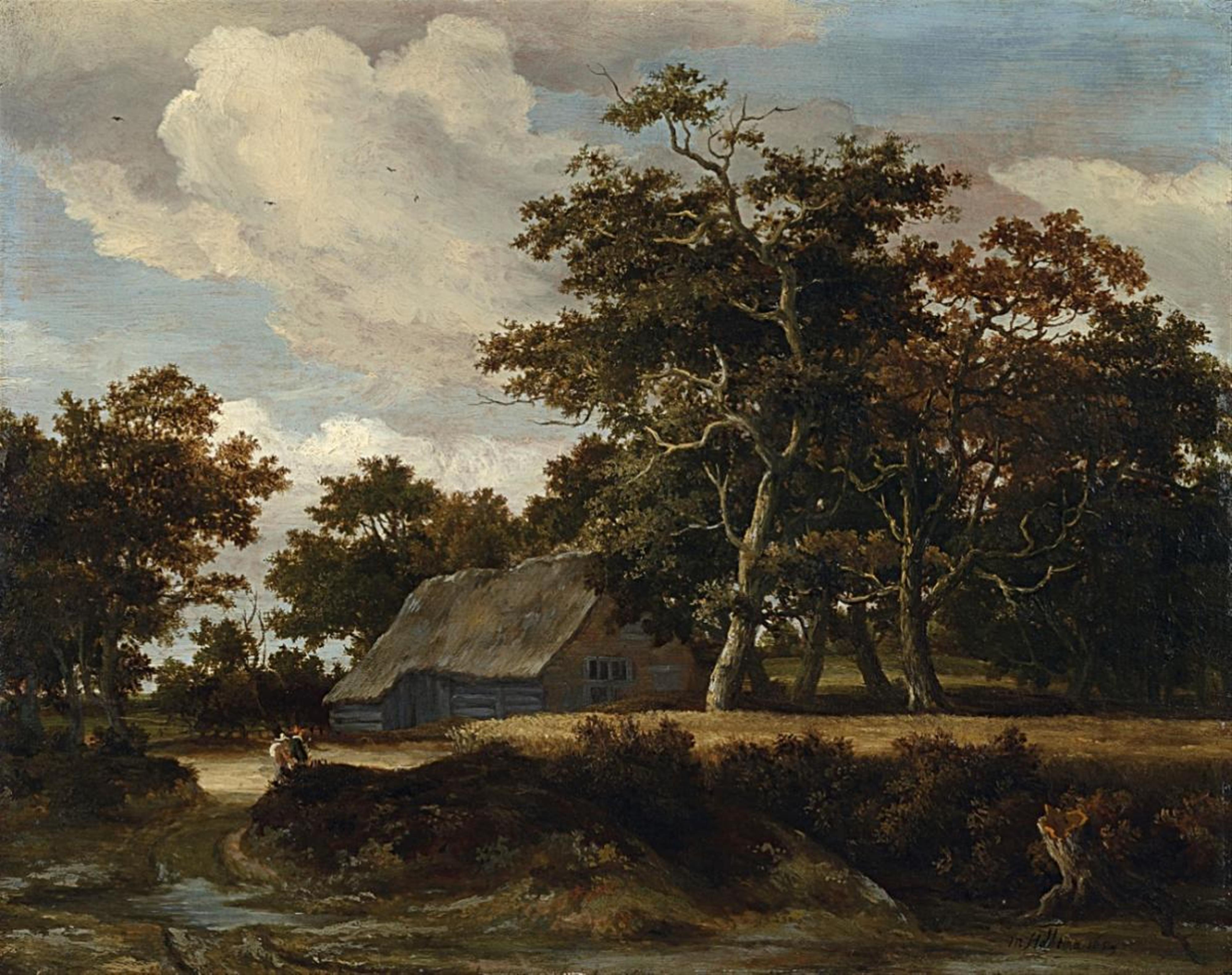Meindert Hobbema
LANDSCHAFT MIT BAUERNHAUS
Öl auf Holz. 34,5 x 43,5 cm.
M. Hobbema 1659.
Unser Gemälde ist ein frühes Werk des gerade 21jährigen Meindert Hobbema. Als er es 1659 malte, arbeitete er noch unter der Leitung von Jacob van Ruysdael. Dennoch ist bereits die Handschrift des bedeutenden Landschaftsmalers so weit entwickelt, dass sie vollends erkennbar ist. Dabei fällt insbesondere die horizontale Gliederung der Bildfläche auf, bei der sich helle Partien von dunklen absetzen. Häufig malt Hobbema unter den Bäumen gedrungene Gebäude wie hier die grau-braune Kate. Charakteristisch ist auch die sparsame Staffage, die in diesem Fall aus einem einsamen Bauernpaar besteht. Dieses ist sehr ähnlich mit dem auf dem großen Bild aus der Sammlung des Fürsten Liechtenstein von 1655 - wo es allerdings in die entgegengesetzte Richtung geht. Wie auf vielen und auch späteren Werken führt ein sandiger Weg von der vorderen linken Ecke diagonal in das Bild hinein.
Von wenigen Ausnahmen abgesehen sind die datierten Werke Hobbemas alle zwischen 1658 und 1668 entstanden. Dies war zweifellos das Jahrzehnt seiner größten Produktivität und schöpferischen Kraft. Die bereits früh ausgeprägte Landschaftsauffassung seiner bewaldeten Dünenlandschaften hat über Generationen die Betrachter seiner Bilder begeistert. So schreibt etwa John Constable 1824: "Wenn es die Seestücke van de Veldes, die Wasserfälle Ruysdaels und die heimischen Wälder Hobbemas nicht gäbe: wäre die Welt nicht um viele charakteristische Kunstwerke ärmer?"
This painting is an early work from the 21 year old Meindert Hobbema. Whilst painting it in 1659 he was still working under the tutelage of Jacob van Ruisdael. However, the style of this important landscape artist was already so far developed that it is fully recognisable in the picture. In particular, the horizontal structure of the picture surface stands out, where the light areas contrast with the dark. Hobbema often painted squat buildings under the trees, such as the grey-brown cottage here. The minimal number of decorative figures is also typical, in this case consisting only of a farming couple. This is comparable to the large picture from the Fürsten Liechtenstein collection of 1655, although they are depicted coming from the opposite direction. As seen in many works, including later examples, a sandy path leads diagonally into the scene from the lower left corner.
Apart from only a few exceptions, all the dated works from Hobbema are from between 1658 and 1668. This decade was without doubt his most productive and creative. With an early developed, distinctive landscape concept, his wooded dune landscapes have inspired viewers of his pictures over the generations. John Constable wrote in 1824: 'What if Vander Velde had quitted his sea pieces, or Ruysdael his waterfalls, or Hobbema his native woods. The world would have lost so many features in art?'
Zertifikat
Christopher Wright, 18. August 1980.
Provenienz
S. van der Stel, Amsterdam (1781). - J. R. Mills (1879). - Sotheby´s London (1973). - Deutsche Privatsammlung.
Literaturhinweise
C. Hofstede de Groot, Bd. IV, 1911, S. 386, Nr. 49 h.
Ausstellung
London, Royal Academy: "17th Century Art in Europe", 1938, Nr. 251.

